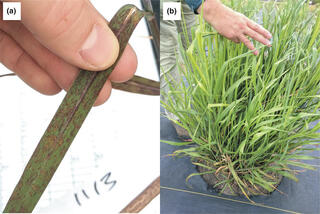Geographic variation in the genetic basis of resistance to leaf rust between locally adapted ecotypes of the biofuel crop switchgrass (Panicum virgatum)
A. VanWallendael et al. "Geographic variation in the genetic basis of resistance to leaf rust between locally adapted ecotypes of the biofuel crop switchgrass (Panicum virgatum)" New Phytologist 227 (2020) [DOI: 10.1111/nph.16555]
Local adaptation is an important process in plant evolution, which can be impacted by differential pathogen pressures along environmental gradients. However, the degree to which pathogen resistance loci vary in effect across space and time is incompletely described. To understand how the genetic architecture of resistance varies across time and geographic space, we quantified rust (Puccinia spp.) severity in switchgrass (Panicum virgatum) plantings at eight locations across the central USA for 3 yr and conducted quantitative trait locus (QTL) mapping for rust progression. We mapped several variable QTLs, but two large-effect QTLs which we have named Prr1 and Prr2 were consistently associated with rust severity in multiple sites and years, particularly in northern sites. By contrast, there were numerous small-effect QTLs at southern sites, indicating a genotype-by-environment interaction in rust resistance loci. Interestingly, Prr1 and Prr2 had a strong epistatic interaction, which also varied in the strength and direction of effect across space. Our results suggest that abiotic factors covarying with latitude interact with the genetic loci underlying plant resistance to control rust infection severity. Furthermore, our results indicate that segregating genetic variation in epistatically interacting loci may play a key role in determining response to infection across geographic space.
R code for QTL analyses is available on GitHub.
